What Is Most Desirable for Nature? An Analysis of Azorean Pupils’ Biodiversity Perspectives When Deciding on Ecological Scenarios
Abstract
:1. Introduction
- -
- Which biodiversity perspectives underlay pupils’ selection of the most desirable hypothetical schemes for nature within different ecological scenarios?
- -
- Which arguments did pupils use to justify the “desirability for nature” of hypothetical schemes within those ecological scenarios?
- -
- What was the impact of pupils’ gender and school level on their scheme selection and justifying arguments?
2. Materials and Methods
2.1. Study Area
2.2. Biodiversity Education in Portuguese and Azorean Educational Curricula
2.3. Data collection Design and Scenarios Description
2.4. Data Analysis
2.5. Sample Characteristics
3. Results
3.1. Pupils’ Selection of the Most Desirable Schemes for Nature
3.2. The Influence of Gender and School Level on Scheme Selection
3.3. Pupils’ Main Justifications for Scheme Selections
3.3.1. Scenario 1: Same Species Richness, Different Evenness
3.3.2. Scenario 2: Different Species Richness, Similar Evenness
3.3.3. Scenario 3: Different Species Richness, Similar Evenness, Different Colonization Mode
4. Discussion
4.1. Most Pupils Made Appropriate Scheme Selections
4.2. Main Biodiversity Perspectives Underlying Pupils’ Choices Focused on Diversity
4.3. Pupils’ Gender and School Level Influences Response Rates and Biodiversity Perspectives
4.4. Capturing Pupils’ Perspectives about Ecological Issues
Supplementary Materials
Author Contributions
Funding
Institutional Review Board Statement
Informed Consent Statement
Data Availability Statement
Acknowledgments
Conflicts of Interest
Appendix A. Category System
| Category | Subcategory | Definition | Examples |
|---|---|---|---|
| AESTHETICS | Aesthetics | When the argument is based on pupils’ sensitivity and is related to the appreciation of beauty in the graphical representation. | Because it is the most beautiful; it is more symmetrical. |
| AUTHORITARIANISM | Authoritarianism | When the argument does not admit a reply, imposing the pupil’s idea. | Because it is the best; just because. |
| CONSERVATION | Ethnocentrism | Refers to valuing local species and devaluing exotic species for not belonging to the endogroup. | Because only native species should be kept; “Foreign” species can threaten endemic biodiversity. |
| Extinction risk | Refers to the probability of disappearance of a species from a certain location or overall. | Because then it is less likely for species to become extinct; these species are more likely to survive. | |
| General conservation | Refers to the environmental conservation process and goals, and the promotion of sustainability. It refers not to species, but to the ecosystem as a whole, to nature or the planet. | Because this way the species are better protected; because it seems to be the most sustainable. | |
| Species introduction threats | Refers to the negative impacts of species introductions into systems where they are alien (e.g., diseases, competition for food, extinction of local species, etc.). | The introduction of species can harm existing species in the location, becoming authentic pests; because the species in scenario E can become invasive and destroy the food resources of the most present species and lead to extinction (proliferation). | |
| DIVERSITY | Abundance | Refers to the number of individuals per species. | One of the species is more frequent than the other species; there are more individuals. |
| Diversity value | Refers to the variability introduced in the system by individuals or species, where the focus is not the total number of individuals or species. | It has more biodiversity; because diversity is higher. | |
| Evenness | Refers to the relative abundance of the various species present in a system. | Because they [species] have the same number of individuals; because it has a greater equilibrium. | |
| Richness | Refers to the number of species present in a system. | Because it is better to have more species than fewer species; there are more species. | |
| ECOLOGICAL DYNAMICS | Natural colonization mode | Refers to species colonization with no human intervention. | (Because) They came willingly; because it is a species that appears naturally. |
| Artificial colonization mode | Refers to species colonization with human intervention (intentional and/or non-intentional). | People are the ones who bring the species; most of them were brought from other places by people. | |
| Interspecific interaction | Refers to the non-trophic relationships among distinct species. These can be antagonistic (e.g., competition) or beneficial (e.g., cooperation). | Because when animals attack each other they should have the same number of their kind, as the other; the species being in the same number were able to secure water and survive better. | |
| Naturalness | When the argument involves a comparison of what occurs in environments without human intervention, and favoring the interests of species or nature. | It is part of the natural cycle; because it is not normal to have the same number of species in the same habitat, it varies. | |
| Reproduction capacity | Refers to the possibility of species propagation, ensuring future generations (includes breeding behavior, opportunity for encountering breeding partner; unbalanced sex ratio; …). | Because there are always species that reproduce more than others; because even though there are more species in smaller numbers, they can reproduce themselves. | |
| Spatial interaction | Refers to space occupation by species and to neighborhood notions between species or individuals. | The individuals are not all together; because each species is spread over several sites | |
| Trophic structure | Refers to feeding interactions among individuals from different species. | Because it is necessary to have more species at the bottom of the food chain, as they provide food for a greater variety of species; because the “species” (balls) can be preyed upon, and then they have to be in greater numbers to maintain biodiversity. | |
| EGOCENTRISM | Egocentrism | When the argument emphasizes the subject’s power of choice. | I feel like it; it’s my opinion. |
| ETHICS | Ethics | Refers to justice, morals, right to live, among other rights. | People must take care of nature; because human beings must not interfere with the natural cycle of species, but try to save them. |
| EVOLUTION | Speciation | Refers to the development of new species. | Can give origin to new species; for new species to establish (themselves) and give rise to others. |
| Adaptation to original habitat | Refers to species adaptation to the biotic, geographical and/or climatic conditions of the region where they are originally from. | Because one should not bring species from other places, because they are already used to their environment; because it is easier for the species existing on the site to adapt than those that are introduced. | |
| Adaptation to new habitat | Refers to the possible lack of species adaptation to the new biological, geographical and/or climatic conditions of the new location into which the species were introduced. | I think that animals that were born in a certain area should not move to another area because they may not get used to it and may end up dying; animals brought in by people when changing climate from their natural habitat may die. | |
| SOCIAL DYNAMICS | Satisfaction of human interests | Refers to human intentional ecosystem modifications for their own benefit (e.g., agriculture, livestock, tourism). | Because if the species in scenario A are taken as edible, we would have a greater variety of food; they may be needed in different ways, so that one species is more useful or needed than another. |
| DON’T KNOW | Don’t know | When the respondent admits that he/she does not know how to justify the scheme chosen. | I don’t know; I can’t explain. |
References
- Lindenmayer, D.; Hobbs, R.; Montague-Drake, R.; Alexandra, J.; Bennett, A.; Burgman, M.; Cale, P.; Calhoun, A.; Cramer, V.; Cullen, P.; et al. A checklist for ecological management of landscapes for conservation. Ecol. Lett. 2007, 11, 78–91. [Google Scholar] [CrossRef]
- McShane, T.O.; Hirsch, P.D.; Trung, T.C.; Songorwa, A.; Kinzig, A.; Monteferri, B.; Mutekanga, D.; Van Thang, H.; Dammert, J.L.; Pulgar-Vidal, M.; et al. Hard choices: Making trade-offs between biodiversity conservation and human well-being. Biol. Conserv. 2011, 144, 966–972. [Google Scholar] [CrossRef]
- Pascual, U.; Adams, W.M.; Díaz, S.; Lele, S.; Mace, G.M.; Turnhout, E. Biodiversity and the challenge of pluralism. Nat. Sustain. 2021, 4, 567–572. [Google Scholar] [CrossRef]
- Hogan, K. Small groups’ ecological reasoning while making an environmental management decision. J. Res. Sci. Teach. 2002, 39, 341–368. [Google Scholar] [CrossRef]
- Grace, M.M.; Ratcliffe, M. The science and values that young people draw upon to make decisions about biological conservation issues. Int. J. Sci. Educ. 2002, 24, 1157–1169. [Google Scholar] [CrossRef]
- Reed, M.S. Stakeholder participation for environmental management: A literature review. Biol. Conserv. 2008, 141, 2417–2431. [Google Scholar] [CrossRef]
- Jordan, R.; Singer, F.; Vaughan, J.; Berkowitz, A. What should every citizen know about ecology? Front. Ecol. Environ. 2009, 7, 495–500. [Google Scholar] [CrossRef]
- McBride, B.B.; Brewer, C.A.; Berkowitz, A.R.; Borrie, W.T. Environmental literacy, ecological literacy, ecoliteracy: What do we mean and how did we get here? Ecosphere 2013, 4, 67. [Google Scholar] [CrossRef]
- McBride, B.B. Essential Elements of Ecological Literacy and the Pathways to Achieve it: Perspectives of Ecologists. Ph.D. Thesis, The University of Montana, Missoula, MT, USA, 2011. [Google Scholar]
- Pitman, S.D.; Daniels, C.B.; Sutton, P.C. Ecological literacy and socio-demographics: Who are the most eco-literate in our community, and why? Int. J. Sustain. Dev. World Ecol. 2016, 25, 9–22. [Google Scholar] [CrossRef]
- Secretariat of the Convention on Biological Diversity (CBD). Convention Text. Available online: https://www.cbd.int/convention/articles/?a=cbd-02 (accessed on 10 June 2021).
- Kilinc, A.; Yeşiltaş, N.K.; Kartal, T.; Demiral, Ü.; Eroğlu, B. School Students’ Conceptions about Biodiversity Loss: Definitions, Reasons, Results and Solutions. Res. Sci. Educ. 2013, 43, 2277–2307. [Google Scholar] [CrossRef]
- Bermudez, G.M.A.; Lindemann-Matthies, P. “What Matters Is Species Richness”—High School Students’ Understanding of the Components of Biodiversity. Res. Sci. Educ. 2020, 50, 2159–2187. [Google Scholar] [CrossRef]
- European Commission. Special Eurobarometer 379—Attitudes of Europeans towards Biodiversity; European Commission: Bruxelles, Belgium, 2013. [Google Scholar]
- Nisiforou, O.; Charalambides, A.G. Assessing Undergraduate University Students’ Level of Knowledge, Attitudes and Behaviour Towards Biodiversity: A case study in Cyprus. Int. J. Sci. Educ. 2012, 34, 1027–1051. [Google Scholar] [CrossRef]
- Pitman, S.D.; Daniels, C.B.; Sutton, P.C. Characteristics associated with high and low levels of ecological literacy in a western society. Int. J. Sustain. Dev. World Ecol. 2017, 25, 227–237. [Google Scholar] [CrossRef]
- Kelemen-Finan, J.; Scheuch, M.; Winter, S. Contributions from citizen science to science education: An examination of a biodiversity citizen science project with schools in Central Europe. Int. J. Sci. Educ. 2018, 40, 2078–2098. [Google Scholar] [CrossRef]
- Cobern, W.W. Everyday thoughts about Nature: A Worldview Investigation of Important Concepts Students Use to Make Sense of Nature with Specific Attention of Science; Springer: Dordrecht, The Netherlands, 2000. [Google Scholar] [CrossRef]
- Fischer, A.; Young, J.C. Understanding mental constructs of biodiversity: Implications for biodiversity management and conservation. Biol. Conserv. 2007, 136, 271–282. [Google Scholar] [CrossRef]
- Dikmenli, M. Biology student teachers’ conceptual frameworks regarding biodiversity. Education 2010, 130, 479–488. [Google Scholar]
- Schneiderhan-Opel, J.; Bogner, F.X. Between Environmental Utilization and Protection: Adolescent Conceptions of Biodiversity. Sustainability 2019, 11, 4517. [Google Scholar] [CrossRef] [Green Version]
- Picanço, A.; Arroz, A.M.; Amorim, I.R.; Matos, S.; Gabriel, R. Teachers’ perspectives and practices on biodiversity web portals as an opportunity to reconnect education with nature. Environ. Conserv. 2021, 48, 25–32. [Google Scholar] [CrossRef]
- Jime’nez-Aleixandre, M.-P. Knowledge producers or knowledge consumers? Argumentation and decision making about environmental management. Int. J. Sci. Educ. 2002, 24, 1171–1190. [Google Scholar] [CrossRef]
- Menzel, S.; Bögeholz, S. The Loss of Biodiversity as a Challenge for Sustainable Development: How Do Pupils in Chile and Germany Perceive Resource Dilemmas? Res. Sci. Educ. 2009, 39, 429–447. [Google Scholar] [CrossRef] [Green Version]
- Regional Statistical Service of the Azores—Serviço Regional de Estatística dos Açores (SREA). Demografia 2018 (Report). Available online: https://srea.azores.gov.pt (accessed on 10 January 2021).
- Myers, N.; Mittermeier, R.A.; Mittermeier, C.G.; Da Fonseca, G.A.; Kent, J. Biodiversity hotspots for conservation priorities. Nature 2000, 403, 853–858. [Google Scholar] [CrossRef]
- Borges, P.A.V.; Costa, A.; Cunha, R.; Gabriel, R.; Gonçalves, V.; Martins, A.F.; Melo, I.; Parente, M.; Raposeiro, P.; Santos, R.S.; et al. (Eds.) A List of the Terrestrial and Marine Biota from the Azores, 1st ed.; Princípia: Cascais, Portugal, 2010. [Google Scholar]
- Queiroz, R.E.; Guerreiro, J.; Ventura, M.A. Demand of the tourists visiting protected areas in small oceanic islands: The Azores case-study (Portugal). Environ. Dev. Sustain. 2014, 16, 1119–1135. [Google Scholar] [CrossRef]
- Ponte, J.C.; De Maneio, P.D.F.; Couto, G.; Pimentel, P.; Oliveira, A. Tourism activities and companies in a sustainable adventure tourism destination: The Azores. Tour. Manag. Stud. 2018, 14, 25–38. [Google Scholar] [CrossRef]
- Ministry of Education-Department of Secondary Education. Biology and Geology Program. Available online: http://www.dge.mec.pt/sites/default/files/Secundario/Documentos/Documentos_Disciplinas_novo/Curso_Ciencias_Tecnologias/Biologia_Geologia/biologia_geologia_10.pdf. (accessed on 2 June 2021).
- Regional Regulatory Decree no. 17/2011/A. Presidency of the Government of the Autonomous Region of the Azores. Official Gazette. Available online: https://data.dre.pt/eli/decregulreg/17/2011/08/02/a/dre/pt/html (accessed on 21 May 2021).
- Sorin, R. Scenario-based learning: Transforming tertiary teaching and learning. In Proceedings of the 8th QS Asia Pacific Professional Leaders in Education Conference, Bali, Indonesia, 14–16 November 2012; pp. 71–81. [Google Scholar]
- Dreyfus, A.; Wals, A.E.J.; Weelie, D.V. Biodiversity as a postmodern theme for environmental education. Can. J. Environ. Educ. 1999, 4, 155–175. [Google Scholar]
- Gaston, K.J.; Spicer, J.I. Biodiversity: An introduction, 2nd ed.; Wiley-Blackwell: Oxford, UK, 2004; p. 208. [Google Scholar]
- Borges, P.A.V.; Lobo, J.M.; de Azevedo, E.B.; Gaspar, C.S.; Melo, C.; Nunes, L.V. Invasibility and species richness of island endemic arthropods: A general model of endemic vs. exotic species. J. Biogeogr. 2006, 33, 169–187. [Google Scholar] [CrossRef] [Green Version]
- Karbach, J. Using Toulmin’s model of argumentation. J. Teach. Write 1987, 6, 81–91. [Google Scholar]
- Braun, V.; Clarke, V. Using thematic analysis in psychology. Qual. Res. Psychol. 2006, 3, 77–101. [Google Scholar] [CrossRef] [Green Version]
- MacQueen, K.M.; McLellan-Lemal, E.; Kay, K.; Milstein, B. Codebook Development for Team-Based Qualitative Analysis. CAM J. 1998, 10, 31–36. [Google Scholar] [CrossRef]
- Randolph, J.J. Online Kappa Calculator [Computer Software] 2008. Available online: http://justusrandolph.net/kappa/ (accessed on 28 January 2021).
- Gabriel, R. Biodiversidade: Breve apresentação. In Nos Trilhos dos Açores: Educação Para a Cidadania, 1st ed.; Bettencourt, A.M., Gomes, M.C., Eds.; Tinta-da-China: Lisboa, Portugal, 2014; pp. 149–151. [Google Scholar]
- Guerrero, A.M.; Barnes, M.; Bodin, Ö.; Chadès, I.; Davis, K.J.; Iftekhar, S.; Morgans, C.; Wilson, K.A. Key considerations and challenges in the application of social-network research for environmental decision making. Conserv. Biol. 2020, 34, 733–742. [Google Scholar] [CrossRef]
- Buijs, A.E.; Fischer, A.; Rink, D.; Young, J. Looking beyond superficial knowledge gaps: Understanding public representations of biodiversity. Int. J. Biodivers. Sci. Manag. 2008, 4, 65–80. [Google Scholar] [CrossRef]
- Stevenson, K.T.; Peterson, M.N.; Bondell, H.; Mertig, A.G.; Moore, S.E. Environmental, Institutional, and Demographic Predictors of Environmental Literacy among Middle School Children. PLoS ONE 2013, 8, e59519. [Google Scholar] [CrossRef] [PubMed]
- Papadopoulos, A. Integrating the Natural Environment in Social Work Education: Sustainability and Scenario-based Learning. Aust. Soc. Work. 2019, 72, 233–241. [Google Scholar] [CrossRef]
- Borges, P.A.; Gabriel, R.; Fattorini, S. Biodiversity erosion: Causes and consequences. In Life on Land. Encyclopedia of the UN Sustainable Development Goals; Leal Filho, W., Azul, A., Brandli, L., Özuyar, P., Wall, T., Eds.; The Springer Nature: Dordrech, The Netherlands, 2019. [Google Scholar] [CrossRef]
- Regional Legislative Decree no. 16/2019/A. Legislative Assembly of the Autonomous Region of the Azores. Official Gazette. Available online: https://data.dre.pt/eli/declegreg/16/2019/07/23/a/dre (accessed on 22 May 2021).
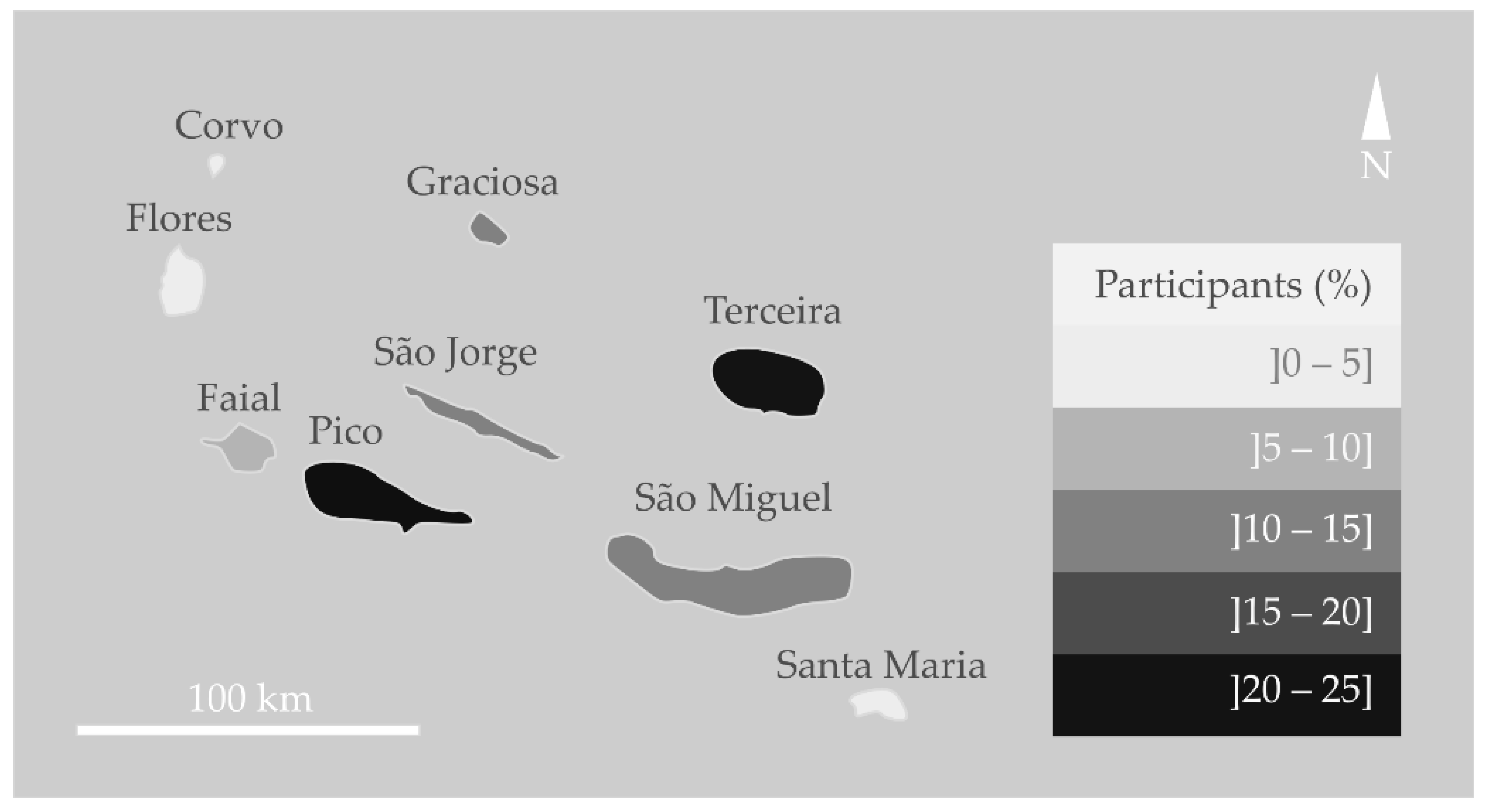
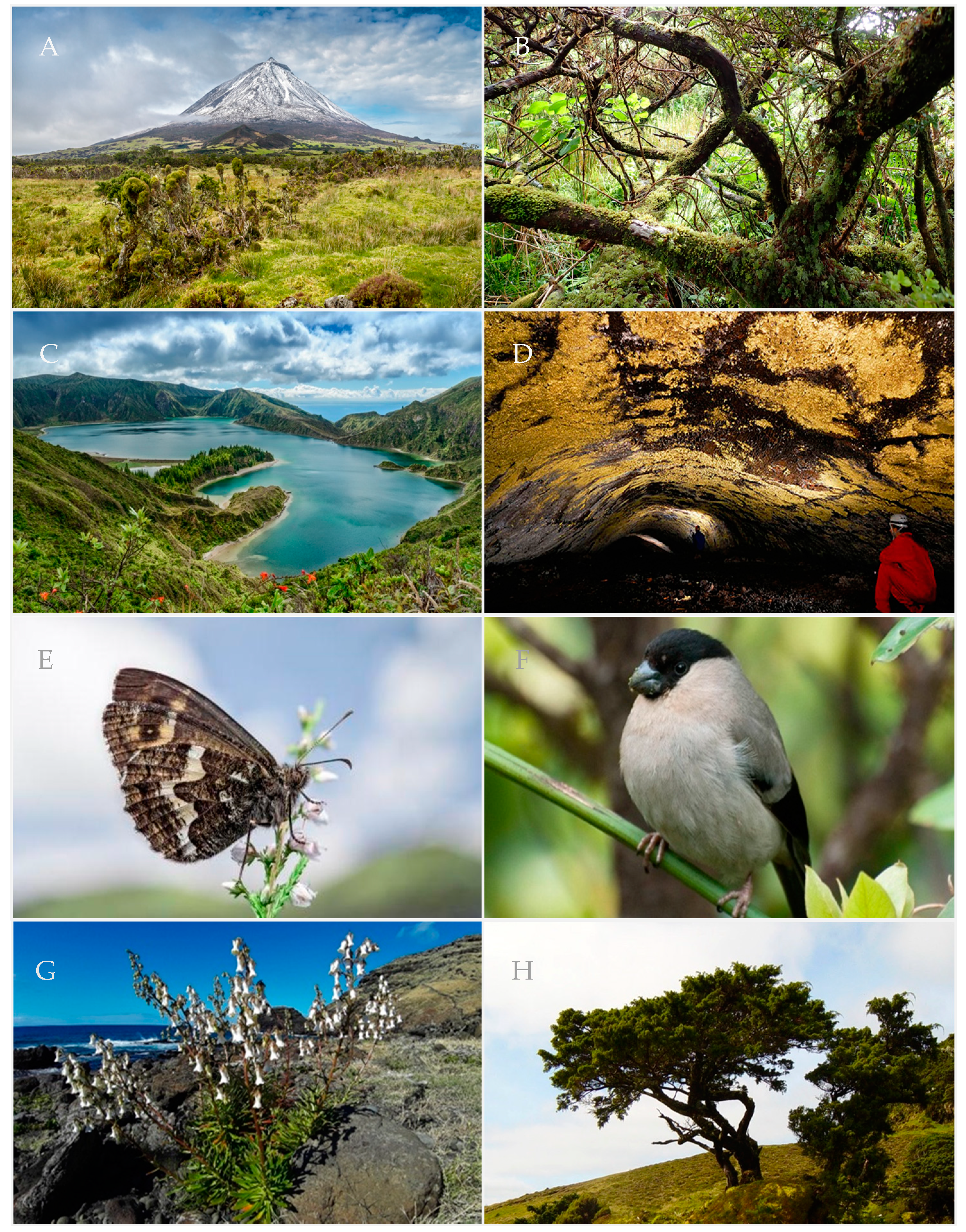
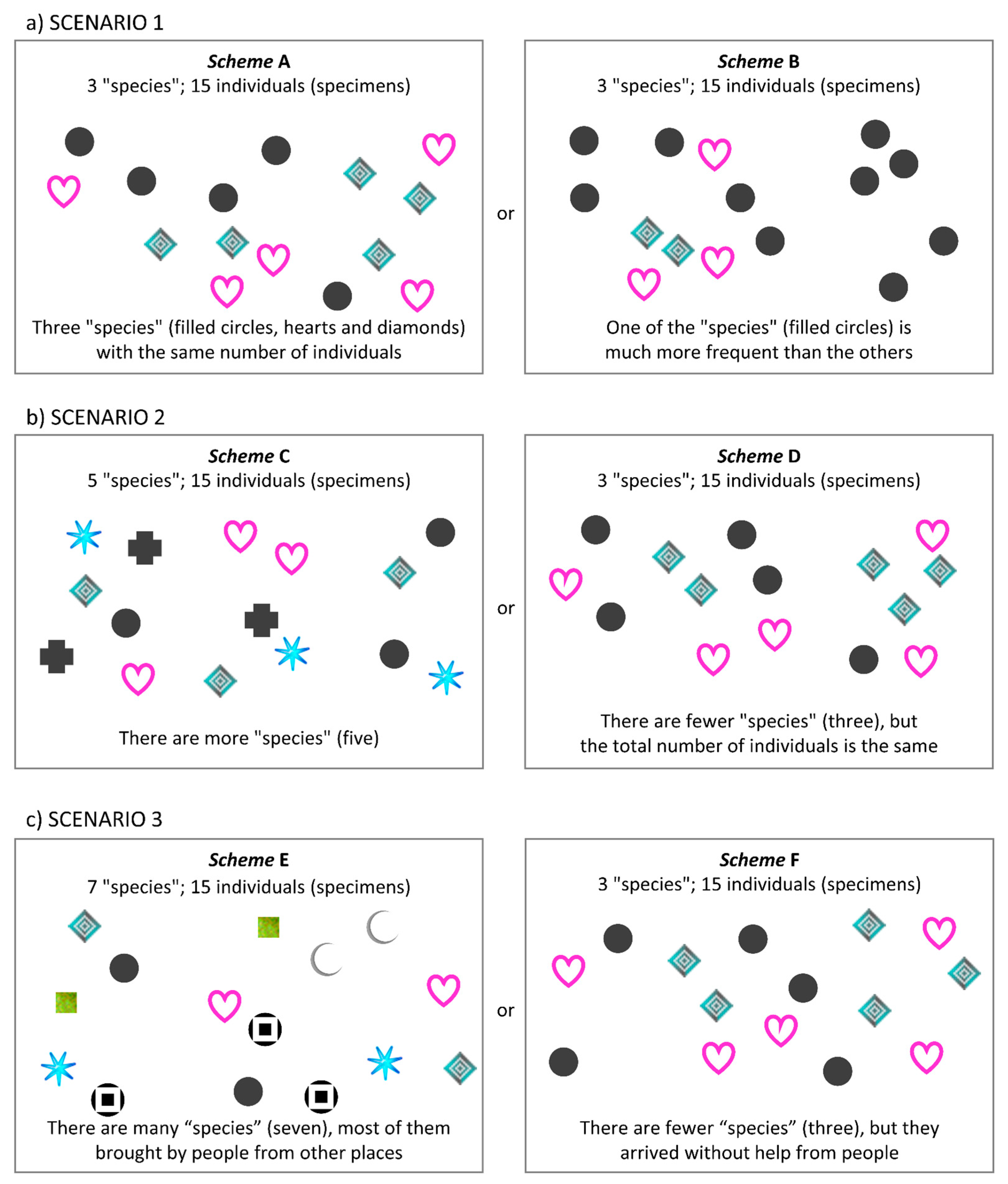
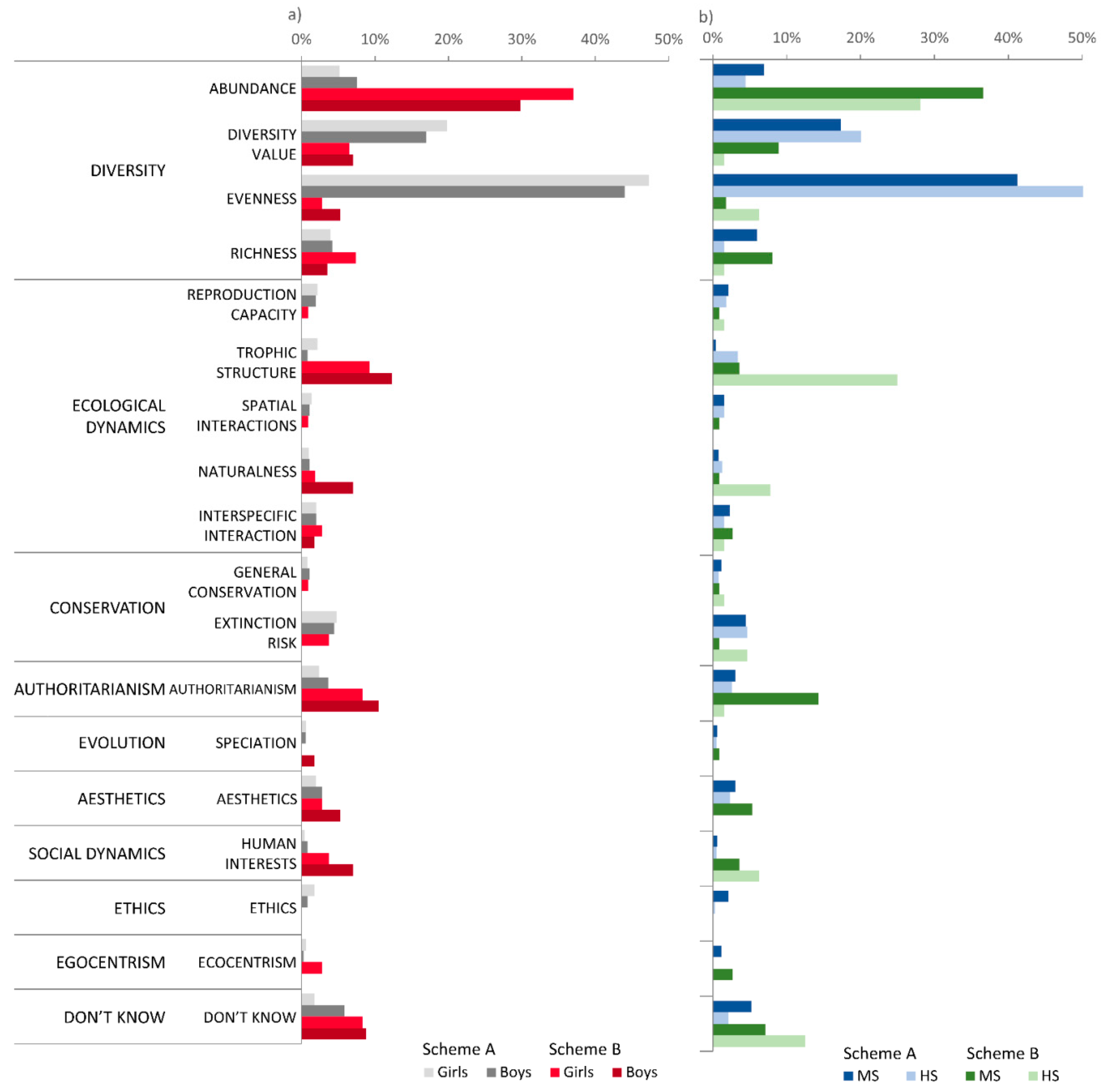
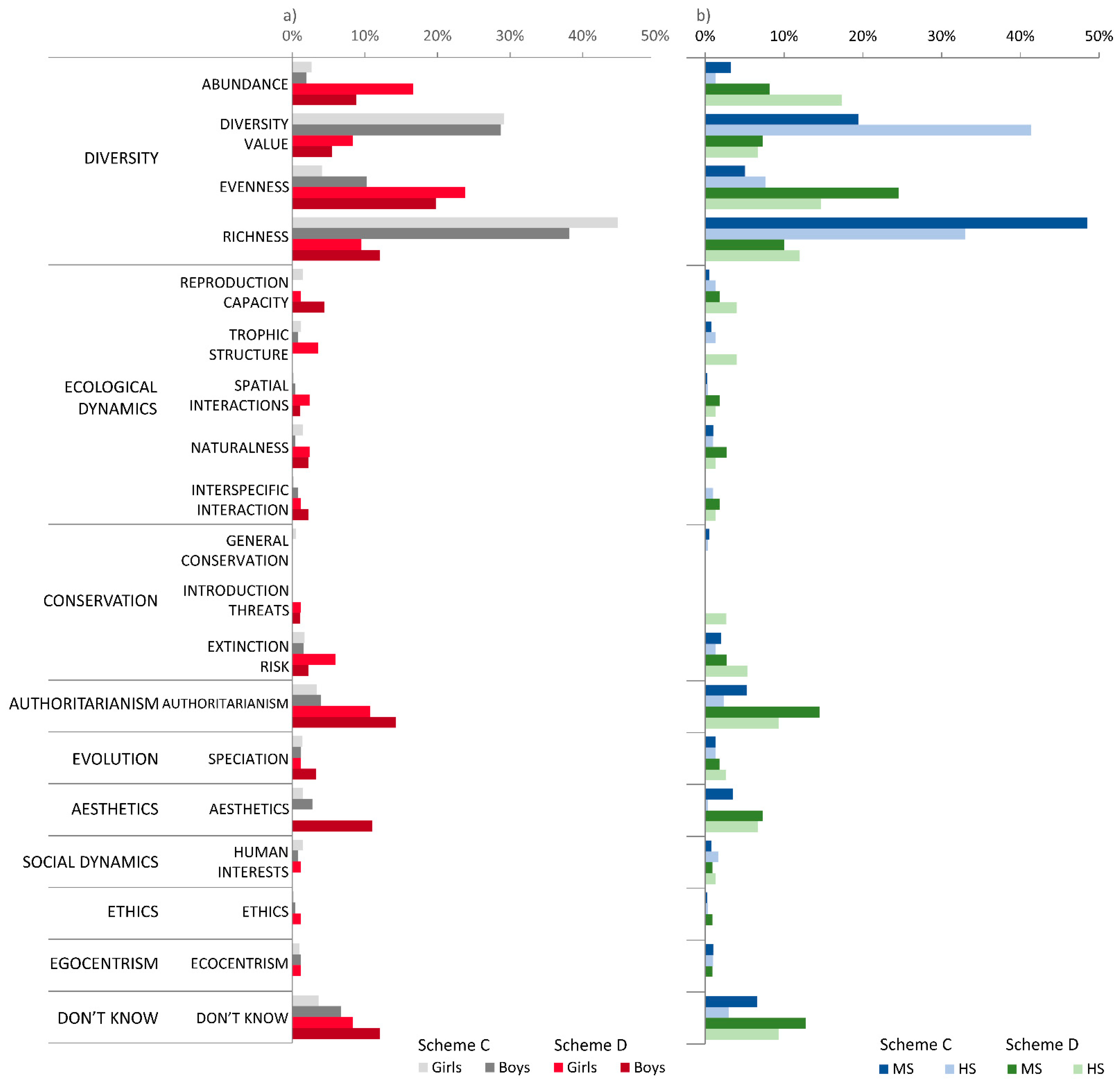
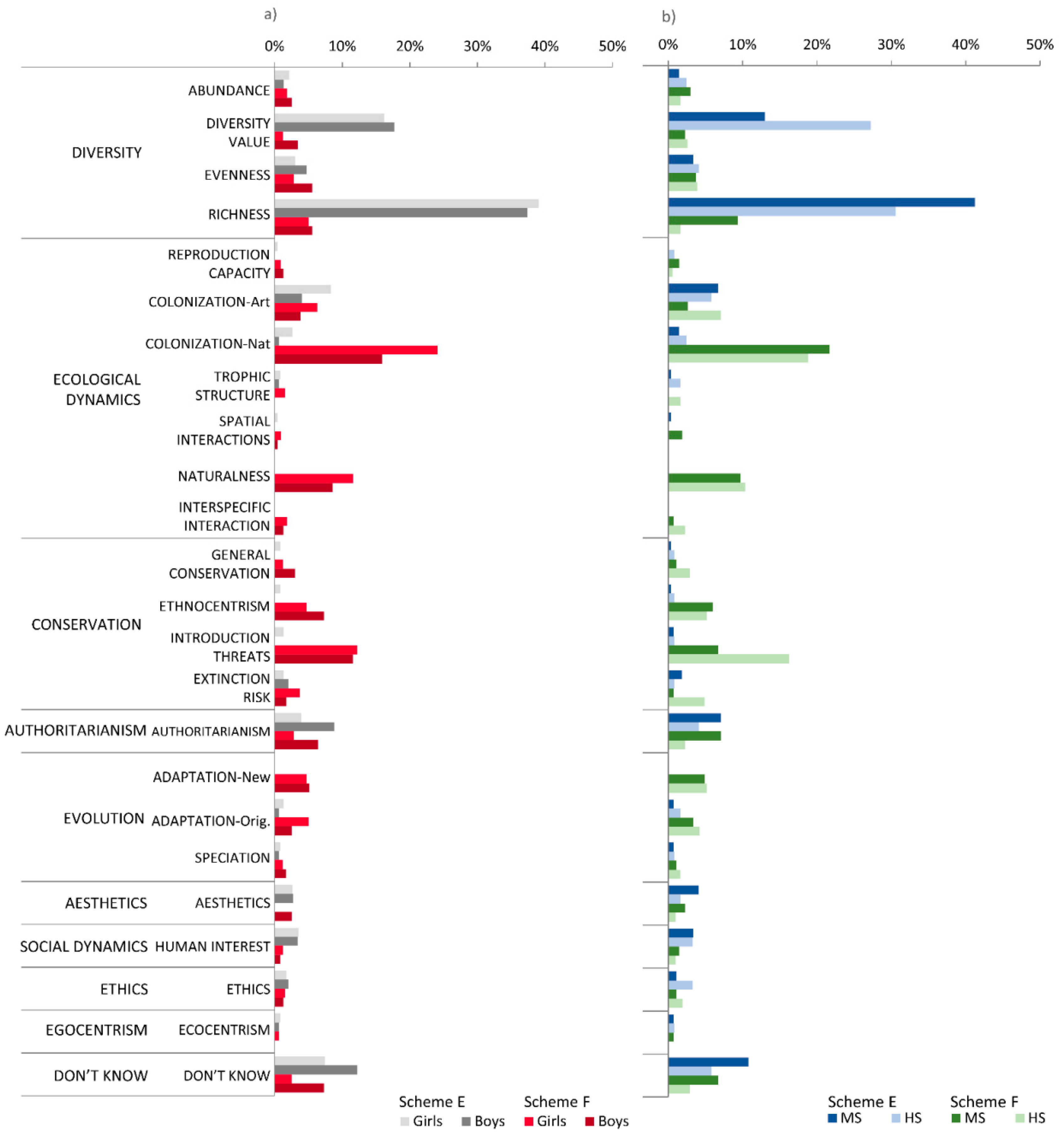
| Scenario | Biodiversity Components | Scheme | Richness (N° of Species) | Evenness (Berger–Parker) | Total Number of Individuals | Colonization Mode | Expected Answer |
|---|---|---|---|---|---|---|---|
| 1 | Same species richness, different evenness | A | 3 | 0.333 | 15 | - | A |
| B | 3 | 0.667 | 15 | - | |||
| 2 | Different species richness, similar evenness | C | 5 | 0.200 | 15 | - | C |
| D | 3 | 0.333 | 15 | - | |||
| 3 | Different species richness, similar evenness, different colonization mode | E | 7 | 0.200 | 15 | Artificial | F |
| F | 3 | 0.333 | 15 | Natural |
| Characteristic | Description | Number (N) and Percentage (%) |
|---|---|---|
| Gender | Girl | 757 (56.03%) |
| Boy | 587 (43.45%) | |
| No answer | 184 (0.52%) | |
| Age group | 11–15 years | 935 (61.19%) |
| 16–23 years | 406 (26.57%) | |
| No answer | 187 (12.23%) | |
| School level | Middle School | 1038 (67.93%) |
| 7th | 377 (24.67%) | |
| 8th | 361 (23.63%) | |
| 9th | 300 (19.63%) | |
| High School | 490 (32.07%) | |
| 10th | 272 (17.80%) | |
| 11th | 121 (7.92%) | |
| 12th | 97 (6.35%) | |
| School’s island group | Western Group | 71 (4.65%) |
| Corvo | 9 (0.59%) | |
| Flores | 62 (4.06%) | |
| Central Group | 1174 (76.83%) | |
| Faial | 113 (7.40%) | |
| Pico | 301 (19.70%) | |
| São Jorge | 214 (14.01%) | |
| Graciosa | 169 (11.06%) | |
| Terceira | 377 (24.67%) | |
| Eastern Group | 283 (18.52%) | |
| São Miguel | 215 (14.07%) | |
| Santa Maria | 68 (4.45%) |
| Scenario Scheme | Gender | School Level | Total | ||||
|---|---|---|---|---|---|---|---|
| Girl | Boy | NR | MS | HS | |||
| 1 | A | 536 (70.8%) | 392 (66.8%) | 63 (34.2%) | 374 (76.3%) | 617 (59.4%) | 991 (64.9%) |
| B | 139 (18.4%) | 90 (15.3%) | 18 (9.8%) | 65 (13.3%) | 182 (17.5%) | 247 (16.2%) | |
| DK | 5 (0.7%) | 5 (0.9%) | 0 (0.0%) | 4 (0.8%) | 6 (0.6%) | 10 (0.7%) | |
| NR | 77 (10.2%) | 100 (17.0%) | 103 (56.0%) | 47 (9.6%) | 233 (22.4%) | 280 (18.3%) | |
| 2 | C | 508 (67.1%) | 328 (55.9%) | 52 (28.3%) | 325 (66.3%) | 563 (54.2%) | 888 (58.1%) |
| D | 132 (17.4%) | 127 (21.6%) | 21 (11.4%) | 97 (19.8%) | 183 (17.6%) | 280 (18.3%) | |
| DK | 5 (0.7%) | 9 (1.5%) | 0 (0.0%) | 4 (0.8%) | 10 (1.0%) | 14 (0.9%) | |
| NR | 112 (14.8%) | 123 (21.0%) | 111 (60.3%) | 64 (13.1%) | 282 (27.2%) | 346 (22.6%) | |
| 3 | E | 309 (40.8%) | 204 (34.8%) | 28 (15.2%) | 142 (29.0%) | 399 (38.4%) | 541 (35.4%) |
| F | 336 (44.4%) | 253 (43.1%) | 36 (19.6%) | 277 (56.5%) | 348 (33.5%) | 625 (40.9%) | |
| DK | 5 (0.7%) | 6 (1.0%) | 2 (1.1%) | 3 (0.6%) | 10 (1.0%) | 13 (0.9%) | |
| NR | 107 (14.1%) | 124 (21.1%) | 118 (64.1%) | 68 (13.9%) | 281 (27.1%) | 349 (22.8%) | |
| Schemes | X2 | d.f. | p-Value | N | |
|---|---|---|---|---|---|
| Gender | A vs. B | 0.65 | 1 | 0.419 | 1157 |
| C vs. D | 7.82 | 1 | 0.005 | 1095 | |
| E vs. F | 1.15 | 1 | 0.284 | 1102 | |
| School level | A vs. B | 11.27 | 1 | 0.001 | 1238 |
| C vs. D | 0.35 | 1 | 0.552 | 1168 | |
| E vs. F | 41.14 | 1 | 0.000 | 1166 | |
| MS and Gender | A vs. B | 0.32 | 1 | 0.570 | 740 |
| C vs. D | 3.87 | 1 | 0.049 | 702 | |
| E vs. F | 3.76 | 1 | 0.053 | 699 | |
| HS and Gender | A vs. B | 0.46 | 1 | 0.497 | 417 |
| C vs. D | 2.83 | 1 | 0.092 | 403 | |
| E vs. F | 0.48 | 1 | 0.487 | 403 |
Publisher’s Note: MDPI stays neutral with regard to jurisdictional claims in published maps and institutional affiliations. |
© 2021 by the authors. Licensee MDPI, Basel, Switzerland. This article is an open access article distributed under the terms and conditions of the Creative Commons Attribution (CC BY) license (https://creativecommons.org/licenses/by/4.0/).
Share and Cite
Piasentin, F.; Gabriel, R.; Arroz, A.M.; Silva, A.R.; Amorim, I.R. What Is Most Desirable for Nature? An Analysis of Azorean Pupils’ Biodiversity Perspectives When Deciding on Ecological Scenarios. Sustainability 2021, 13, 12554. https://doi.org/10.3390/su132212554
Piasentin F, Gabriel R, Arroz AM, Silva AR, Amorim IR. What Is Most Desirable for Nature? An Analysis of Azorean Pupils’ Biodiversity Perspectives When Deciding on Ecological Scenarios. Sustainability. 2021; 13(22):12554. https://doi.org/10.3390/su132212554
Chicago/Turabian StylePiasentin, Flora, Rosalina Gabriel, Ana M. Arroz, Alexandra R. Silva, and Isabel R. Amorim. 2021. "What Is Most Desirable for Nature? An Analysis of Azorean Pupils’ Biodiversity Perspectives When Deciding on Ecological Scenarios" Sustainability 13, no. 22: 12554. https://doi.org/10.3390/su132212554
APA StylePiasentin, F., Gabriel, R., Arroz, A. M., Silva, A. R., & Amorim, I. R. (2021). What Is Most Desirable for Nature? An Analysis of Azorean Pupils’ Biodiversity Perspectives When Deciding on Ecological Scenarios. Sustainability, 13(22), 12554. https://doi.org/10.3390/su132212554







